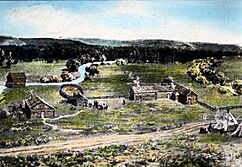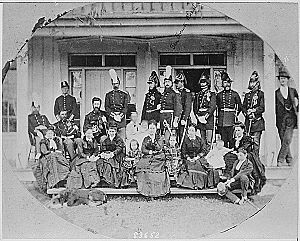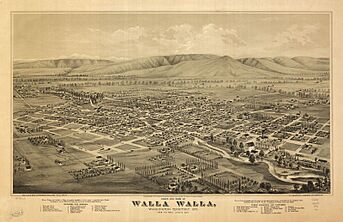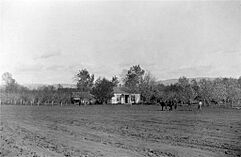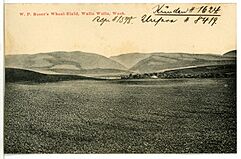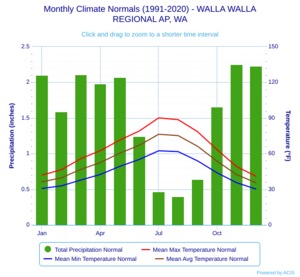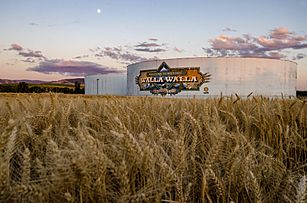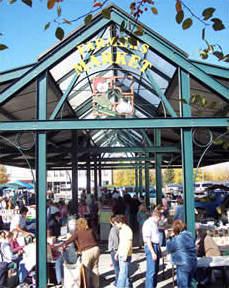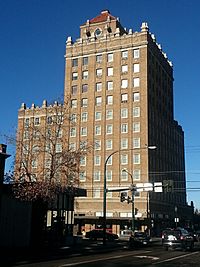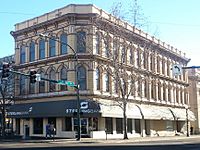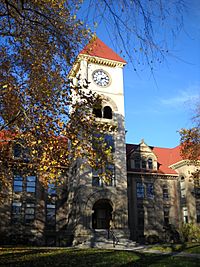Walla Walla, Washington facts for kids
Quick facts for kids
Walla Walla
|
||
|---|---|---|
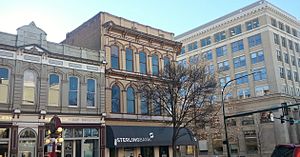
Reynolds–Day Building, Sterling Bank, and Baker Boyer Bank buildings in downtown Walla Walla
|
||
|
||
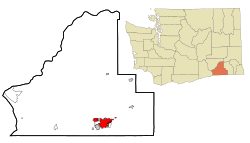
Location of Walla Walla, Washington
|
||
| Country | United States | |
| State | Washington | |
| County | Walla Walla | |
| Government | ||
| • Type | Council–manager | |
| • Body | City council | |
| Area | ||
| • City | 13.88 sq mi (35.95 km2) | |
| • Land | 13.85 sq mi (35.86 km2) | |
| • Water | 0.03 sq mi (0.08 km2) | |
| Elevation | 942 ft (287 m) | |
| Population
(2020)
|
||
| • City | 34,060 | |
| • Estimate
(2023)
|
33,339 | |
| • Density | 2,376.14/sq mi (917.42/km2) | |
| • Urban | 55,805 (US: 464th) | |
| • Metro | 62,682 (US: 382th) | |
| Time zone | UTC−8 (PST) | |
| • Summer (DST) | UTC−7 (PDT) | |
| ZIP Code |
99362
|
|
| Area code | 509 | |
| FIPS code | 53-75775 | |
| GNIS feature ID | 1512769 | |
Walla Walla is a city in Washington, United States. It is the main city of Walla Walla County. In 2020, about 34,060 people lived here. By 2023, the population was estimated to be around 33,339. If you include the nearby towns of College Place and Walla Walla East, the total population is about 45,000.
Walla Walla is in the southeastern part of Washington. It's about a four-hour drive from Portland, Oregon, and four and a half hours from Seattle. The city is also very close to the Oregon border, only about 6 miles (10 km) north of it.
Contents
History of Walla Walla
Native Peoples and Early Explorers
The story of Walla Walla began in 1806. That's when the Lewis and Clark expedition met the Walawalałáma near the Walla Walla River. Other native groups like the Cayuse, Umatilla, and Nez Perce also lived in the valley.
In 1818, a fur trading post called Fort Walla Walla was built. It was an important stop in the Oregon Country. Later, missionaries like Marcus and Narcissa Whitman arrived in 1836. They started the Whitman Mission. Over time, there were disagreements between the settlers and the Cayuse people. This led to a sad event where the Whitmans and others were killed in 1847. Today, the mission site is a National Historic Site.
In 1855, a big meeting called the Walla Walla Treaty Council took place. Leaders from the native tribes and the Washington government met. The tribes agreed to give up a lot of land for a native reservation.
How Walla Walla Began
Because of conflicts, the United States Army built a fort in 1856. A small town called "Steptoeville" grew around Fort Walla Walla. In 1858, a ban on new settlers was lifted. This brought many pioneers to the area. They started farms and looked for gold.
On November 17, 1859, the settlement was officially named Walla Walla. The military then moved the remaining native peoples to reservations.
On December 20, 1859, a high school called Whitman Seminary was started. It later became Whitman College in 1882. It is now a four-year private college.
The Mullan Road, a new wagon road, helped connect Walla Walla to more places. When gold was found in 1860, Walla Walla became a key place for miners to get supplies. The city grew quickly because of the gold rush.
Growth and New Businesses
Walla Walla officially became a city on January 11, 1862. Elias Bean Whitman, a cousin of Marcus Whitman, became the first mayor. The city's population grew a lot, making it the biggest city in the Washington Territory for a while.
During the 1860s, many important businesses started. The city's first newspaper, the Washington Statesman, began in 1861. The first bank in the state, Baker Boyer Bank, opened in 1869. The city also had its first brick store, a bookstore, and one of the first breweries in the region.
Many Chinese settlers came to Walla Walla during the gold rush. They created a neighborhood called "Chinatown". They worked in stores, mines, and on railroads. After a fire and changes in the railroad plans, many Chinese immigrants moved to other cities.
In 1886, a local businessman gave land for a new prison. This prison, the Washington State Penitentiary, opened in 1887. It is still an important part of the city today.
Farming Becomes Key
After the gold rush, Walla Walla became a major farming area. It was known as the "garden city." It grew famous for onions, apples, peas, and wine grapes.
Italian settlers helped start the gardening industry. They planted vineyards and opened the first wine tasting rooms in the 1880s. They also grew the famous Walla Walla sweet onion, which is now Washington State's official vegetable.
Dryland farming helped Walla Walla become known for its wheat. Many Seventh-day Adventists and Volga Germans came to the city to farm. The area around Walla Walla College (founded by Adventists) eventually became its own city, College Place, Washington.
To help with wheat exports, a railroad was built in 1875. It connected Walla Walla to the Columbia River.
The 1900s and Beyond
In 1911, Walla Walla changed its local government. In 1959, residents voted to use a council–manager government system.
The city's second movie theater, the American Theater, opened in 1917. It later became a department store and then a Macy's.
The Marcus Whitman Hotel was built in 1928. It's the tallest building in the city. It was restored in 1999 and is still open today.
In 1931, Mill Creek flooded Walla Walla, causing a lot of damage. To prevent future floods, the United States Army Corps of Engineers built the Mill Creek Dam and Bennington Lake. These have helped protect the city from floods many times.
During the Great Depression, a local newspaper owner, John Grant Kelly, opened the first cannery in the area. This helped Walla Walla become a big producer of canned green peas.
In the 1970s and 1980s, several wineries started up, bringing back Walla Walla's wine industry. The first brewery since prohibition opened in 1997.
Walla Walla Today
In 2001, Walla Walla won an award for fixing up its downtown area. In 2011, USA Today named Walla Walla the friendliest small city in the U.S. Downtown Walla Walla was also recognized as a "Great Neighborhood" in 2012.
The city's brewery industry has grown again in the 2010s. There are now hops farms and even a plan for a vineyard at the Washington State Penitentiary.
Since 2017, Walla Walla has celebrated "Adam West Day" every September. This honors the actor who played Batman on TV, who was born and grew up in Walla Walla. A statue of him is planned for the city.
What's in a Name?
The name Walla Walla comes from the Nez Perce people. It means "Place of Many Waters." This is because the original settlement was where the Snake and Columbia rivers meet.
Many tourists hear the saying, "Walla Walla, a town so nice they named it twice." This saying was made popular by the entertainer Al Jolson in the early 1900s.
Some locals and people from Walla Walla also call the city "W2" in text messages.
Geography and Climate
Walla Walla is in the Walla Walla Valley. To the north are the rolling Palouse hills, and to the east are the Blue Mountains. Several creeks flow through the town and join to form the Walla Walla River. This river then flows into the Columbia River about 30 miles (48 km) west.
The city gets less rain because it's in the "rain shadow" of the Cascade Mountains.
Walla Walla has a warm, dry summer climate, similar to places around the Mediterranean Sea. Even though it's far north, it has mild winters compared to other places at the same latitude.
| Climate data for Walla Walla, Washington (Walla Walla Regional Airport), 1991–2020 normals, extremes 1949–present | |||||||||||||
|---|---|---|---|---|---|---|---|---|---|---|---|---|---|
| Month | Jan | Feb | Mar | Apr | May | Jun | Jul | Aug | Sep | Oct | Nov | Dec | Year |
| Record high °F (°C) | 70 (21) |
75 (24) |
79 (26) |
96 (36) |
100 (38) |
116 (47) |
114 (46) |
114 (46) |
104 (40) |
89 (32) |
81 (27) |
71 (22) |
116 (47) |
| Mean maximum °F (°C) | 61.3 (16.3) |
62.0 (16.7) |
69.8 (21.0) |
78.1 (25.6) |
88.9 (31.6) |
97.0 (36.1) |
104.2 (40.1) |
102.3 (39.1) |
92.5 (33.6) |
79.0 (26.1) |
66.6 (19.2) |
61.0 (16.1) |
105.7 (40.9) |
| Mean daily maximum °F (°C) | 41.9 (5.5) |
46.5 (8.1) |
55.8 (13.2) |
62.5 (16.9) |
71.4 (21.9) |
79.0 (26.1) |
90.1 (32.3) |
88.6 (31.4) |
78.5 (25.8) |
63.4 (17.4) |
49.2 (9.6) |
41.0 (5.0) |
64.0 (17.8) |
| Daily mean °F (°C) | 36.3 (2.4) |
39.7 (4.3) |
46.8 (8.2) |
52.5 (11.4) |
60.4 (15.8) |
67.0 (19.4) |
76.3 (24.6) |
75.2 (24.0) |
66.2 (19.0) |
53.9 (12.2) |
43.9 (6.6) |
35.6 (2.0) |
54.3 (12.4) |
| Mean daily minimum °F (°C) | 30.7 (−0.7) |
32.9 (0.5) |
37.8 (3.2) |
42.5 (5.8) |
49.3 (9.6) |
55.1 (12.8) |
62.4 (16.9) |
61.7 (16.5) |
53.9 (12.2) |
43.9 (6.6) |
35.6 (2.0) |
30.2 (−1.0) |
44.7 (7.1) |
| Mean minimum °F (°C) | 16.3 (−8.7) |
20.2 (−6.6) |
26.8 (−2.9) |
32.3 (0.2) |
37.9 (3.3) |
45.4 (7.4) |
51.4 (10.8) |
50.6 (10.3) |
41.8 (5.4) |
30.1 (−1.1) |
21.7 (−5.7) |
15.4 (−9.2) |
8.4 (−13.1) |
| Record low °F (°C) | −18 (−28) |
−16 (−27) |
4 (−16) |
20 (−7) |
26 (−3) |
36 (2) |
40 (4) |
42 (6) |
32 (0) |
15 (−9) |
−11 (−24) |
−24 (−31) |
−24 (−31) |
| Average precipitation inches (mm) | 2.10 (53) |
1.59 (40) |
2.11 (54) |
1.98 (50) |
2.07 (53) |
1.24 (31) |
0.47 (12) |
0.40 (10) |
0.64 (16) |
1.66 (42) |
2.25 (57) |
2.23 (57) |
18.74 (476) |
| Average snowfall inches (cm) | 1.0 (2.5) |
2.2 (5.6) |
0.2 (0.51) |
0.0 (0.0) |
0.0 (0.0) |
0.0 (0.0) |
0.0 (0.0) |
0.0 (0.0) |
0.0 (0.0) |
0.1 (0.25) |
0.3 (0.76) |
2.7 (6.9) |
6.5 (17) |
| Average precipitation days (≥ 0.01 in) | 13.3 | 11.2 | 12.1 | 11.1 | 9.8 | 7.1 | 2.7 | 2.5 | 3.8 | 8.8 | 13.1 | 13.6 | 109.1 |
| Average snowy days (≥ 0.1 in) | 2.3 | 1.5 | 0.3 | 0.0 | 0.0 | 0.0 | 0.0 | 0.0 | 0.0 | 0.1 | 0.5 | 2.4 | 7.1 |
| Mean monthly sunshine hours | 50.5 | 83.4 | 173.8 | 221.7 | 288.5 | 326.3 | 384.5 | 344.4 | 268.8 | 199.2 | 67.8 | 40.3 | 2,449.2 |
| Percent possible sunshine | 18 | 29 | 47 | 54 | 62 | 69 | 81 | 79 | 71 | 59 | 24 | 15 | 51 |
| Source: NOAA (sun 1961–1987) | |||||||||||||
People of Walla Walla
| Historical population | |||
|---|---|---|---|
| Census | Pop. | %± | |
| 1870 | 1,394 | — | |
| 1880 | 3,588 | 157.4% | |
| 1890 | 4,709 | 31.2% | |
| 1900 | 10,049 | 113.4% | |
| 1910 | 19,364 | 92.7% | |
| 1920 | 15,503 | −19.9% | |
| 1930 | 15,976 | 3.1% | |
| 1940 | 18,109 | 13.4% | |
| 1950 | 24,102 | 33.1% | |
| 1960 | 24,536 | 1.8% | |
| 1970 | 23,619 | −3.7% | |
| 1980 | 25,618 | 8.5% | |
| 1990 | 26,478 | 3.4% | |
| 2000 | 29,686 | 12.1% | |
| 2010 | 31,731 | 6.9% | |
| 2020 | 34,060 | 7.3% | |
| 2023 (est.) | 33,339 | 5.1% | |
| U.S. Decennial Census 2020 Census |
|||
In 2020, Walla Walla had 34,060 people living in 12,414 homes. The city had about 2,478 people per square mile.
In 2010, there were 31,731 people and 11,537 homes. Most residents (81.6%) were White. About 22% of the population was Hispanic or Latino.
The average age in Walla Walla was 34.4 years. About 22% of residents were under 18.
Economy and Jobs
Farming and Food
Even though wheat is still a big crop, vineyards and wineries have become very important. In 2020, there were over 120 wineries in the Walla Walla area. This growth has also led to many nice restaurants and hotels, like the Marcus Whitman Hotel.
The Walla Walla Sweet Onion is a special crop. Over a century ago, a French soldier brought a sweet onion seed from Italy. Farmers in Walla Walla grew this onion, making it sweeter and rounder over many years. It is now Washington's official state vegetable. It's known for being very sweet and having low sulfur. There's even a Walla Walla Sweet Onion Festival every July!
Walla Walla has two farmers markets from May to October. You can find fresh local produce there.
The Wine Industry
The wine industry in Walla Walla has grown a lot. The area was named "Best Wine Region" by USA Today in 2020 and 2021. Many local wineries have won top awards. There are more than 120 wineries, bringing over $100 million to the valley each year.
Walla Walla Community College offers a degree in winemaking and grape growing. They even have their own winery.
Growing grapes can be tricky because of the risk of a hard freeze in winter. These freezes can damage a lot of the grape crop.
The Prison's Role
The Washington State Penitentiary (WSP) is in Walla Walla. It's the second-largest prison in Washington. It opened in 1886 and now holds about 2,000 people. About 1,000 staff members work there. In 2005, the prison brought about $55 million to the local economy through jobs and purchases. The prison has expanded to hold more people and create more jobs.
City Services and Travel
Healthcare
Walla Walla has two main hospitals. They are St. Mary Medical Center and the Jonathan M. Wainwright Veteran's Affairs Medical Center.
Getting Around
You can travel to Walla Walla by air through the Walla Walla Regional Airport. There are also several railroads and highways. U.S. Route 12 is the main highway. It connects Walla Walla to other major interstates. State Route 125 also runs through the city.
There are four main bus services in the area. Valley Transit serves Walla Walla and nearby College Place. There are also buses to Milton-Freewater, Oregon, and a longer bus service called the Grape Line that goes to Pasco.
Sports and Fun
Walla Walla is home to the Walla Walla Sweets, a summer baseball team. College players play for the Sweets at Borleske Stadium. The team has been very successful, even playing in the league championship.
The Walla Walla Drag Strip is a place for drag racing. It's located on an old airport runway.
There's also a women's roller derby team called the Walla Walla Sweets Rollergirls. They practice and play at the Walla Walla YMCA.
The Tour of Walla Walla is a bike race held every April. It includes different types of races through the city and nearby hills.
The annual Walla Walla Marathon takes place in October. It includes a full marathon, a half-marathon, and a 10k race. The full marathon is a qualifying race for the Boston Marathon.
Arts and Culture
Walla Walla has many groups and places for fine and performing arts.
- The Walla Walla Valley Bands have a Concert Band and two Jazz Ensembles.
- The Walla Walla Symphony started in 1907. They perform concerts from October to May.
- The Walla Walla Chamber Music Festival happens twice a year. Musicians play classical music in small venues.
- Shakespeare Walla Walla hosts a summer Shakespeare festival. They bring theater groups to perform plays.
- The GESA Powerhouse Theatre opened in 2011. It was once a gas plant. It's used for Shakespeare plays, concerts, and other events.
- The Little Theatre of Walla Walla has been performing plays since 1944.
- The Walla Walla Choral Society performs several concerts each year.
- The Walla Walla Foundry was started in 1980.
The local colleges and high school also put on theater and music shows.
Learning and Schools
Walla Walla Public Schools runs seven elementary schools, two middle schools, and three high schools. There's also a program for homeschooling families.
Several private Christian schools are in the area:
- The Walla Walla Catholic Schools (Assumption K-8 School and DeSales High School)
- Liberty Christian School
- Rogers Adventist School and Walla Walla Valley Academy (both in College Place)
- Saint Basil Academy of Classical Studies (K-8)
Walla Walla also has three colleges:
- Walla Walla Community College
- Whitman College, a private liberal arts college
- Walla Walla University, in College Place
Sister City
Since 1972, Walla Walla has been a sister city with Sasayama (now called Tamba-Sasayama), Japan. The cities have named roads after each other. They also host exchange students from Tamba-Sasayama. These exchanges help promote peace and understanding between the two cultures.
Famous People from Walla Walla
Many interesting people have come from Walla Walla, including:
- Drew Bledsoe, a famous NFL quarterback
- Walter Brattain, a Nobel Prize winner who helped invent the transistor
- Adam West, the actor who played Batman on TV
- Sally Buzbee, a top editor at the Washington Post
See also
 In Spanish: Walla Walla (Washington) para niños
In Spanish: Walla Walla (Washington) para niños



